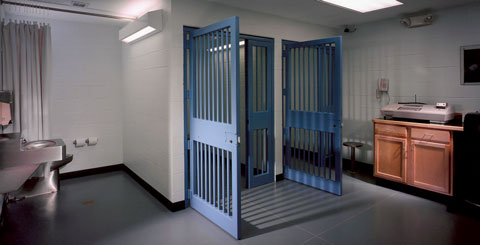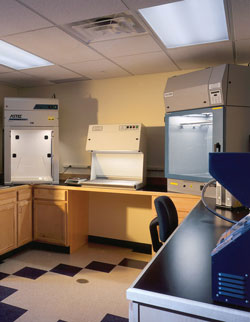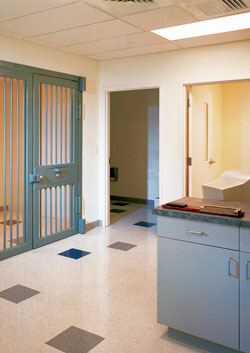Publications
Small Town Justice - Focus on Local Police Facilities
Andrea Murray, AIA, NCARB, LEED APGovernment spending at the Federal, State, and local levels for policing and public safety has risen significantly in recent years. A more security-conscious society and concern for drug-related crimes are leading to an increased need for services.
Employment of police, detectives, and supporting staff is expected to grow faster than the average of all occupations (21%-35%) through 2012. Specifically, smaller local police facilities are struggling to accommodate growing forces and the increased needs of their communities. This is good news for the design and construction industries, and even better news for design-builders.

Current Condition and Location of Police Buildings
Many rural and sub-urban police stations have been operating from old, out-of-date facilities often connected to or part of a town’s late 19th /early 20th century municipal facility. Not only are these facilities short of space, but they are deficient in technology and often lack code-required amenities for women and handicapped staff.
According to Chief Thomas Hanley of the Middlebury, Vermont Police Department, modern police organizations have identified and recognize the need for their facilities to project an image of “permanence and strength without looking like a courthouse.” That said, the Chief went on to include that they must also have an “immediate calming effect on the inside.” This change in the way police facilities are perceived has also contributed to the need for new facilities. According to Chief Hanley and many other police chiefs, these new facilities need to be driver accessible, which sometimes makes downtown locations inappropriate. They also want to be somewhat private, as not everyone wants to be seen dealing with a crisis at the police station; another reason for moving away from town centers.
As we begin to plan for the relocation of such facilities, the planners among us recognize that strategic placement of a public use facility, especially one that houses the local police force, has the potential to revitalize a whole neighborhood. In addition, we need to recognize that unlike the warren of the municipal building, these buildings have a much more complex, multi-functioning purpose. Often the program will include more than the communications hub and officer facilities; it may be used as a jail, a courthouse, a crisis and disaster center, and community meeting spaces.
Why Design/Build for these Facilities?
GMP & The Bond Vote
Design Builders are emerging as the preferred providers of building solutions for small-scale justice projects. This is primarily due to our ability to provide a guaranteed maximum price (GMP) and reliable construction schedule upon completion of the schematic design stage of a project. As these projects are paid for with taxpayer dollars, having a committed cost and schedule allows the public to assess the feasibility of the project scope and design early in the process, with a minimal upfront investment.
Generally, once a scope of work has been defined and the GMP agreed upon, the financial funding viability of the project is approved by a bond vote. Note that the design builder can commit more energy to design upfront than an architect operating on his or her own. We have a greater incentive to help the client’s bond vote pass, as the design builder anticipates a more significant long-term gain. This is good for us but also an advantage to our police clients that may not at first be so apparent. The schematic design is apt to be more developed, with fewer stones left unturned.
In addition, having a GMP allows a locality or public institution to transfer the risks of unanticipated costs and delays to the contractor. We offer them a virtually risk-free proposition. On our side, we bring the entire team together at the beginning: estimating, design, civil, structural, mechanical, electrical, plumbing, and construction. The expertise of the entire team is brought to bear on the various components of the project, allowing us to evaluate (or perform a value analysis of) upfront and lifecycle costs.

Single-Source Responsibility
Another significant benefit of design-build for our police clients is the single-source responsibility we assume for the project. As one might imagine, law enforcement is an environment burdened with constant stressful situations. The last thing a police chief needs to deal with is a building project and its associated architects, construction managers, subcontractors, and the like. And, the number of parties involved in a justice project is considerable due to the complexity of its program and operating systems. This single-source responsibility also translates to a single point of contact for the client; one source of information, one person responsible for conveying and implementing the overall project mission from conception through completion. An extra value to these clients is our ability to shop vendors of specialties. For example, should we purchase a pre-fabricated jail cell unit or have one custom assembled on site of parts from various source? Are we simply looking for the least expensive alternatives that meet our quality expectations, or should we be subcontracting within the project region - investing in and supporting the local economy?
Understand the Multi-Headed Client
While we trumpet our single-source responsibility and our capacity to collect, organize, and analyze an enormous amount of information from our designers, consultants, and subcontractors, we must recognize that our client is also a multi-faceted participant in the project. Small-town justice clients comprise a building committee of many entities, including local government officials, police staff, other users, and public representatives. Ultimately these projects are about building community relationships. It is our job to understand the pressures that exist for all members of this client component and to unify their many project values - present them as one voice. For this task, the design builder is uniquely qualified.
The design builder ultimately ends up being a two-way communication device, quite like a double-ended funnel. While on one side we coordinate the various design and construction disciplines, we are also responsible for the many objectives of our client. Being in this position allows us to harness an enormous amount of potential energy and speed up the project in the process.
Faster, Faster, Faster
Time is one of the biggest advantages to design/build. Design/build eliminates, or at least reduces considerably, the lapses in time generally occurred for communication from one consultant to the next. In addition, we can often begin construction while certain design elements are still being worked out. Time is of the essence to law enforcement organizations—the better equipped their home base, the more effective they can be at fighting crime.
No COWs (Clerks of the Works)
A design builder assuming single-source responsibility for a project may eliminate the need for a COW. Traditionally, a public entity would hire a COW to provide on-site supervision of the construction process. The clerk would pay close attention to detail and account for all the contract specifications, measure the contractor’s work, regulate construction lines and levels, and assure the quality of materials used. The COW would represent the architect’s project requirements to the construction manager on behalf of the owner. By creating an atmosphere of mutual trust between the client and design builder, we do away with finger pointing and need for a COW, thereby eliminating a substantial cost from the project budget.
While some of these benefits are not unique to police justice facilities, they do resonate soundly for public projects.
Integrated Design for Police Facilities
As of late, many state and local governments are introducing legislation that will require all new and renovated public facilities to adhere to fairly strict green building guidelines. The hope is that public buildings can set an example, or precedent, for the community at large.
So why is design/build a good facilitator of green building design and construction for police facilities? Because we already practice integrated design.
The U.S. Department of Energy defines Integrated Design as:
- A process that often includes integrating green design strategies into conventional design criteria for building form, function, performance, and cost. The key to successful integrated building design is the participation of people from different specialties of design (and related disciplines): architecture, HVAC, lighting and electrical, interior design, civil and site engineering, etc.
- In addition, integrated design may include members of the community, transportation officials, utility representatives, community planners, and whomever else might provide valuable insight into the ultimate project solution.
- Police facilities are excellent candidates for energy efficient design solutions, primarily because of their 24-hour, seven day-a-week operation. They expend a huge amount of energy.
- Police facilities are also good candidates for the adaptive reuse of existing municipal properties or buildings. Code requirements for many of the programmed spaces in this type of building are not as stringent as those for other municipal and commercial projects. This makes conversion of such existing buildings much easier logistically.
- In Middlebury, Vermont, the town reclaimed an old sewage treatment site for its new police facility. In Pelham, New Hampshire, the police department was able to renovate an abandoned elementary school for its facility. In Littleton, New Hampshire, the police are studying an old hospital as a possible retrofit for their operation.

Lessons and Pointers
To reduce the amount of the municipal bond and the risk of the vote failing, small justice clients often try to take certain components of the project scope upon themselves. Two of the most common items to end up as owner’s scope are communications and security technology. Such clients might think that their intimate knowledge of these systems qualifies them to coordinate these services more efficiently. While in some cases this might be true, remember that this project is not your client’s full-time job. Remember, too, that the coordination required for these very complex systems is extensive and intense. The time spent communicating such technology needs from client consultants and contractors to the client and eventually to the design builder is tremendous, and bits of information are inevitably lost or miscommunicated. Advise your client not to make this mistake.
In addition, toward the end of the project, remember that your very orderly police client has gotten used to your seamless, conflict-free project approach. So, stay on top of local utilities to make sure their service installations do not delay occupancy.
In Conclusion
While most of us are convinced design/build is the best solution for most any building project, this rings true especially for small-town justice facilities. As Chief Hanley decisively summarized his design/build experience, “Bread Loaf told me this was the maximum price for the project and that they’d take care of everything. How can that not be the best way to go?”

-
Realizing the Client’s Vision : Design-Build Creates A Landmark for Orvis
Bread Loaf Corporation
Manchester, VT — When the Orvis Company decided to locate its flagship retail store in Manchester, it was adamant that its new facility would be far more than just an attractive new store. Orvis wanted the building and its...
-
If You Design and Build It…They Will Come
Andrea Murray, AIA, NCARB, LEED AP
Ready to go the distance, sports and recreation clients come to Bread Loaf Corporation hoping we can turn their dreams into reality. They look to us to help them conceptualize, visualize, rationalize and realize their ideal facilities. We...
-
Partnering with Small Colleges to Envision the Future
Andrea Murray, AIA, NCARB, LEED AP
Achievement, Opportunity, and Growing Pains The list of challenges plaguing small college presidents and administrators these days is significant, with the rising cost of doing business, shrinking endowments (if any), and sustained pressure to grow and compete for...
-
Design-Builders to the Rescue
Andrea Murray, AIA, NCARB, LEED AP
Our Ailing Planet By now, we all realize our planet is ailing and our climate is extremely unstable. The evidence for global warming and related climate change is considerable. We also recognize that this new type of climate...
-
The Little Green Book
Bread Loaf Corporation
Confused about all this talk about Green Building? Let us break it all down for you. This book takes a look at sustainable design and construction and highlights the strategies and benefits of Green Building.
-
Healthy Building = Healthy People
by Andrea Murray, AIA, NCARB, LEED AP
Health Care and Rehabilitation Services of Southeastern Vermont (HCRS) is a multifaceted, non-profit, community mental health agency which has served Vermonters since 1967. By 1990, the agency had evolved into the comprehensive human services provider it is today with major...
